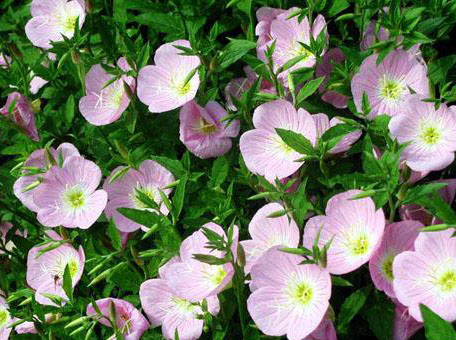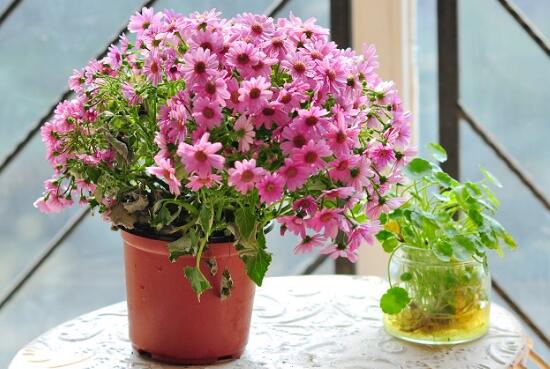How to raise melon-leaf chrysanthemum, breeding methods and precautions of melon-leaf chrysanthemum / fear of high temperature and freezing
Melon leaf chrysanthemum, a very beautiful flower, is very popular with flower friends because of its beautiful and rich colors. In life, because the melon leaf chrysanthemum has a strong effect, so many people want to raise it, then how to raise it? The following are the breeding methods and matters needing attention of melon and leaf chrysanthemum carefully arranged by the editor, which are very detailed. Friends who want to raise must have a look at them.
First, how to raise melon and leaf chrysanthemum and understand their habits

Melon leaf chrysanthemum likes a warm, moist and ventilated environment, it is not resistant to high temperature, but also afraid of cold, in indoor breeding, it should be placed in a place with good light to avoid direct light, and warm measures should be taken in winter. As for cultivated soil, it is better to be sandy soil with good drainage and rich in humus. So how to raise melon and leaf chrysanthemum? It's very simple, just satisfy its growth habits.
II. Culture methods and matters needing attention of Chrysanthemum morifolium
1. Soil
How to raise melon and leaf chrysanthemum, first of all, we should re-choose potted soil. Nowadays, the potted plants of flower friends are basically purchased online, but the soil is very cheap, and normal maintenance can ensure plant growth, but if you want to grow well, you'd better choose the soil again.
Soil selection: according to the growth habits of Chrysanthemum morifolium, it likes sandy soil with good drainage and rich in humus. In this regard, the editor recommends that we use rotten leaf soil, pure loess and fine sand according to 3:1:1 mixed soil.
2. Lighting
Melon leaf chrysanthemum is a plant that likes light, so in the cultivation method of melon leaf chrysanthemum, light is a very key link. Melon leaf chrysanthemum is suitable for growing in an environment with sufficient light, so when raising it indoors, it should be placed in a place with good light.
Note: after flowering, melon-leaf chrysanthemum can be watched indoors, but it should still be allowed to receive several hours of light every day; however, melon-leaf chrysanthemum should avoid strong light and should be properly shaded in summer, otherwise it will cause the leaves of melon-leaf chrysanthemum to curl and affect the ornamental quality.
3. Temperature
How to raise melon and leaf chrysanthemum, timely adjustment of temperature is also very important. Compared with other chrysanthemums, melon-leaf chrysanthemum is relatively cold-tolerant, and the most suitable growth temperature is 10-15 ℃, which should be maintained by conditional flower friends.
Note: although the melon leaf chrysanthemum cold resistance is good, but it is afraid of frost, in the cold winter, we should also pay attention to cold protection and warmth, otherwise, once the temperature is lower than 0 ℃, the plant will produce frost damage; in addition, melon leaf chrysanthemum avoid high temperature, once the growth temperature is too high, it is easy to grow, affecting beauty.
4. Watering
Water is the source of life, so watering is a very important part in the breeding methods and matters needing attention of melon and leaf chrysanthemum. Melon leaf chrysanthemum likes the humid environment, and its leaves are very thin and large, and its transpiration is also very large, so it has a high demand for moisture. Usually, it should be watered frequently. When it is found that the basin soil is dry, it will be watered immediately to keep it moist.
Note: although melon-leaf chrysanthemum likes water, it avoids stagnant water. Once there is stagnant water in the basin soil, it is easy to appear symptoms such as rotten roots and yellow leaves. Therefore, in order to avoid this phenomenon, watering melon and leaf chrysanthemum should follow the principle of "no dry, no watering, watering thoroughly". In addition, we can spray the leaves properly in hot weather.
5. Fertilization
After watering, let's talk about fertilization, it is also indispensable in the growth process of melon and leaf chrysanthemum. Melon leaf chrysanthemum likes fertilizer, and it should be fertilized every 7-10 days during the growing period. the fertilizer can choose light cake fertilizer or 1% nitrogen, phosphorus and potassium compound fertilizer, and the effect of alternating use is better.
Note: to fertilize the melon and leaf chrysanthemum, we must keep in mind that you can't sprinkle it directly on the leaves. If you get it, you should rinse it with clean water in time. In addition, after the flower bud of Chrysanthemum morifolium, we can apply potassium dihydrogen phosphate and stop fertilization after the flower blooms.
6. Diseases and insect pests
In the process of breeding melon leaf chrysanthemum, because of high air humidity, lack of light, poor ventilation and other reasons, melon leaf chrysanthemum is prone to diseases and insect pests such as powdery mildew, Verticillium wilt, aphids, mites and other pests, which will seriously affect the ornamental of the plant. In this regard, we should carry out timely control after discovery, which can refer to the prevention and control of diseases and insect pests of melon and leaf chrysanthemum.
How to raise melon and leaf chrysanthemum? Culture methods and matters needing attention of Chrysanthemum morifolium
Chrysanthemum morifolium is a perennial herb of Compositae, and it is a very popular ornamental flower in daily life. The flowers of melon and leaf chrysanthemum are bright and colorful, giving people a fresh and pleasant feeling, so they are often potted indoors. So, how to raise melon and leaf chrysanthemum? Now the breeding methods and matters needing attention of melon and leaf chrysanthemum are introduced as follows.
Picture: melon leaf chrysanthemum
I. Culture methods of Chrysanthemum morifolium
1. Soil: melon leaf chrysanthemum is native to the Canary Islands in the Atlantic Ocean and is widely cultivated in parks or courtyards all over China. It likes sandy loam soil rich in humus and well drained, avoiding drought, afraid of stagnant water, and suitable for neutral and slightly acidic soil.
two。 Sunshine: melon leaf chrysanthemum likes sunshine during the growing period and should not be shaded. Turn the flowerpot regularly so that the branches and leaves receive light evenly and the plant shape is straight and unskewed. After flower wilting, the plant still needs moderate light to adapt to seed development.
3. Watering: melon leaf chrysanthemum leaves are large and thin, need to maintain sufficient water, but can not make the basin soil too wet, in order to keep the leaves from withering is appropriate. Usually watering should be determined according to the dry and wet condition of the basin soil, and then irrigate once every 2-3 days. Clear water can be sprayed to the leaf surface once a day, and hot weather can be sprayed twice to reduce the temperature and increase the air humidity. After the emergence of buds, watering should be controlled as much as possible, and the flowering period should be placed in a cool environment of 8: 12 ℃, which can prolong the flowering period to 30-40 days.
Picture: melon leaf chrysanthemum
4. Temperature: melon leaf chrysanthemum likes warmth but can not bear high temperature, and grows best under the condition of 15-20 ℃. When the temperature is higher than 21 ℃, the overgrowth phenomenon can occur, which is not conducive to the formation of flower buds. The growth and development of the plant stopped when the temperature was below 5 ℃, and frost injury occurred when the temperature was below 0 ℃. The suitable temperature for flowering was 10: 15 ℃, and it could not open in bud when the temperature was below 6 ℃. When the temperature was higher than 18 ℃, the flower stem would grow slender and affect the ornamental value.
5. Fertilization: in addition to applying base fertilizer during planting, thin cake fertilizer should be applied every 7 to 10 days during growth, or diluted chemical fertilizer can be used. After the appearance of flower buds, 1000 times of potassium dihydrogen phosphate could be applied, and the fertilization lasted until flowering (stopped in rainy season). If the leaves are contaminated during fertilization, they should be washed in time.
6. Insect pests: the common insect diseases of melon and leaf chrysanthemum are aphids and red spiders. For aphids and red spiders, they can be sprayed with 2000 times dimethoate diluent. Because red spiders generally occur on the back of the leaves, and aphids generally occur on the tender top of the chrysanthemum, spraying should focus on the back of the leaves and the top of the plant, and the front of the leaves should also be sprayed properly.
Picture: melon leaf chrysanthemum
II. Matters needing attention in the culture of melon and leaf chrysanthemum
When spraying pesticides, because red spiders generally occur on the back of leaves, while aphids generally occur on the tender top of melon and leaf chrysanthemum, spraying should focus on the back of leaves and the top of plants, and the front of leaves should be sprayed properly. when applying fertilizer, be careful not to sprinkle fertilizer directly on the leaves, wash the leaves in time if they are contaminated, and stop applying fertilizer during flowering. During the growing period, it is necessary to grow in a greenhouse with good light, and after flowering, it should be moved indoors for appreciation, and it should be placed in front of the brightly lit south, west and east windows for at least 4 hours of light every day, so as to keep the flowers bright and the plants strong.
[editor's conclusion] Guaye Chrysanthemum is the main ornamental flower during New Year's Day and Spring Festival, which has a good planting value. The above introduces the breeding methods and matters needing attention of melon and leaf chrysanthemum. Have you all learned it?
How to cultivate Chrysanthemum morifolium Culture methods and matters needing attention
Melon leaf chrysanthemum is a common bonsai flower and ornamental plant decorating the courtyard. How to raise it? Let's take a look at the breeding methods and points for attention of Chrysanthemum morifolium.
Culture methods of Chrysanthemum morifolium:
1. Soil: melon leaf chrysanthemum likes sandy loam rich in humus and good drainage, avoid drought, afraid of stagnant water, and is suitable for neutral and slightly acidic soil.
2. Watering: the leaves of Chrysanthemum morifolium are large and thin, which need to maintain sufficient water, but can not make the basin soil too wet, so it is appropriate to keep the leaves from withering. Usually watering should be determined according to the dry and wet condition of the basin soil, and then irrigate once every 2-3 days. Clear water can be sprayed to the leaf surface once a day, and hot weather can be sprayed twice to reduce the temperature and increase the air humidity. After the emergence of buds, watering should be controlled as much as possible, and the flowering period should be placed in a cool environment of 8-12 ℃, which can prolong the flowering period to 30-40 days.
3. Sunshine: melon-leaf chrysanthemum likes sunshine during the growing period and should not be shaded. Turn the flowerpot regularly so that the branches and leaves receive light evenly and the plant shape is straight and unskewed. After flower wilting, the plant still needs moderate light to adapt to seed development.
4. Temperature: melon leaf chrysanthemum likes warmth but can not bear high temperature, and grows best under the condition of 15-20 ℃. When the temperature is higher than 21 ℃, the overgrowth phenomenon can occur, which is not conducive to the formation of flower buds. When the temperature is below 5 ℃, the growth and development of the plant stops, and the freezing injury occurs when the temperature is below 0 ℃. The suitable temperature for flowering is 10: 15 ℃, which can not open in bud when the temperature is below 6 ℃, and when the temperature is higher than 18 ℃, the flower stem will grow slender and affect the ornamental value.
5. Fertilization: in addition to applying base fertilizer during planting, thin cake fertilizer should be applied every 7-10 days in the growth process, or diluted chemical fertilizer can be used. After the appearance of flower buds, 1-2 times of potassium dihydrogen phosphate could be applied, and fertilization lasted until flowering (stopped in rainy season). If the leaves are contaminated during fertilization, they should be washed in time.
6. Insect pests: the common insect diseases of melon and leaf chrysanthemum are aphids and red spiders. If the damage to aphids and red spiders is more serious, they can be sprayed with 2000 times dimethoate diluent. Because red spiders generally occur on the back of the leaves, and aphids generally occur on the tender top of the chrysanthemum, spraying should focus on the back of the leaves and the top of the plant, and the front of the leaves should also be sprayed properly.
Matters needing attention in melon leaf chrysanthemum culture:
When spraying pesticides, because red spiders generally occur on the back of leaves, and aphids generally occur on the tender top of melon and leaf chrysanthemum, spraying should focus on the back of leaves and the top of the plant, and the front of leaves should also be sprayed properly.
When applying fertilizer, you should be careful not to sprinkle the fertilizer directly on the leaves. If you pollute the leaves, you should wash them in time and stop applying fertilizer during the flowering period.
During the growing period, it is necessary to grow in a greenhouse with good light, and after flowering, it should be moved indoors for appreciation, and it should be placed in front of the brightly lit south, west and east windows for at least 4 hours of light every day, so as to keep the flowers bright and the plants strong.
More information
- Prev

What are the conditions for more blossoms of evening primrose?
Evening primrose, also known as evening primrose, has large yellow flowers, and it can blossom up to 20 on each branch. Generally open at dusk, golden in color, fragrant and generous, gradually turn red in the early morning of the next day, and fade gradually after sunrise. Without manual intervention, the florescence is from June to September.
- Next

How to water melon leaf chrysanthemum, watered once a few days / twice a day in summer / morning and evening
For melon and leaf chrysanthemum, flower friends should be no stranger, it is a kind of Compositae, with beautiful flowers and rich colors. In daily maintenance, melon leaf chrysanthemum is not difficult to manage, but in the simplest watering, many flower friends are prone to mistakes, then how to water melon leaf chrysanthemum home? Melon leaf chrysanthemum is watered for a few days
Related
- Fuxing push coffee new agricultural production and marketing class: lack of small-scale processing plants
- Jujube rice field leisure farm deep ploughing Yilan for five years to create a space for organic food and play
- Nongyu Farm-A trial of organic papaya for brave women with advanced technology
- Four points for attention in the prevention and control of diseases and insect pests of edible fungi
- How to add nutrient solution to Edible Fungi
- Is there any good way to control edible fungus mites?
- Open Inoculation Technology of Edible Fungi
- Is there any clever way to use fertilizer for edible fungus in winter?
- What agents are used to kill the pathogens of edible fungi in the mushroom shed?
- Rapid drying of Edible Fungi

